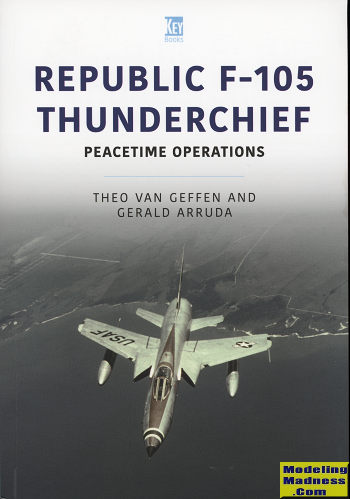 The F-105 was
developed to meet the requirement of a fighter-bomber replacement for the F-84.
As such, it was determined that the aircraft would need to be able to fly at
supersonic speeds. During the design of the plane, the concept of 'area rule'
became widely known with US aircraft designers and so the 105 incorporated this
into the plane's design. Prototypes discovered that the original straight
leading edge intakes were not delivering the amount of air needed by the engine
so a redesign to its now familiar forward swept intakes were enough to deal with
the issue.
The F-105 was
developed to meet the requirement of a fighter-bomber replacement for the F-84.
As such, it was determined that the aircraft would need to be able to fly at
supersonic speeds. During the design of the plane, the concept of 'area rule'
became widely known with US aircraft designers and so the 105 incorporated this
into the plane's design. Prototypes discovered that the original straight
leading edge intakes were not delivering the amount of air needed by the engine
so a redesign to its now familiar forward swept intakes were enough to deal with
the issue.
The aircraft entered service in time to equip several wings and proved to be the
main attack bomber used in the Vietnam War. In fact, nearly half of the planes
produced were lost in either combat or operational accidents during this
conflict. However, they were highly effective in the bomber/ground attack role.
Post war, the type was rapidly taken out of regular USAF service and flown by
the ANG and Reserves until 1984 when the type was retired.
This book is as much a photo book as it is a history of
the type. It concentrates on its use outside the Vietnam War. Thunderbird wings
operated in Europe, the Pacific, and in the US. Each of the wings/squadrons are
covered. Thanks to the wide photo coverage of the type. This means that wide
majority of the images are in full color. This all makes for an excellent book
on the type that will be enjoyed and appreciated by all enthusiasts of the type
and modelers alike.
Development of
the Typhoon started before the start of WWII. It was to be a replacement fighter
for the Hurricane and so, to hedge their bets, there were two nearly idential
types started, each with a different engine. The Typhoon was powered by the
Napier Sabre while the Tornado was to be powered by a Rolls Royce Vulture. The
Vulture was already powering the Manchester bomber but was fraught with
difficulties and just did not turn out to be a reliable engine. Not that it was
all roses for the Sabre as it had its usual teething issues. Development was not
helped with all work on both planes was halted in 1940 in order to concentrate
on building extant types.
July 2022
Copyright ModelingMadness.com. All rights reserved. No
reproduction in part or in whole without express permission.
Review book courtesy of
Casemate Publishing.
You can get yours today
from this link.
If you would like your product reviewed fairly and quickly, please
contact
me or see other details in the
Note to
Contributors.
 The F-105 was
developed to meet the requirement of a fighter-bomber replacement for the F-84.
As such, it was determined that the aircraft would need to be able to fly at
supersonic speeds. During the design of the plane, the concept of 'area rule'
became widely known with US aircraft designers and so the 105 incorporated this
into the plane's design. Prototypes discovered that the original straight
leading edge intakes were not delivering the amount of air needed by the engine
so a redesign to its now familiar forward swept intakes were enough to deal with
the issue.
The F-105 was
developed to meet the requirement of a fighter-bomber replacement for the F-84.
As such, it was determined that the aircraft would need to be able to fly at
supersonic speeds. During the design of the plane, the concept of 'area rule'
became widely known with US aircraft designers and so the 105 incorporated this
into the plane's design. Prototypes discovered that the original straight
leading edge intakes were not delivering the amount of air needed by the engine
so a redesign to its now familiar forward swept intakes were enough to deal with
the issue.